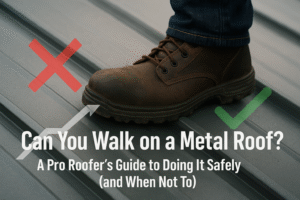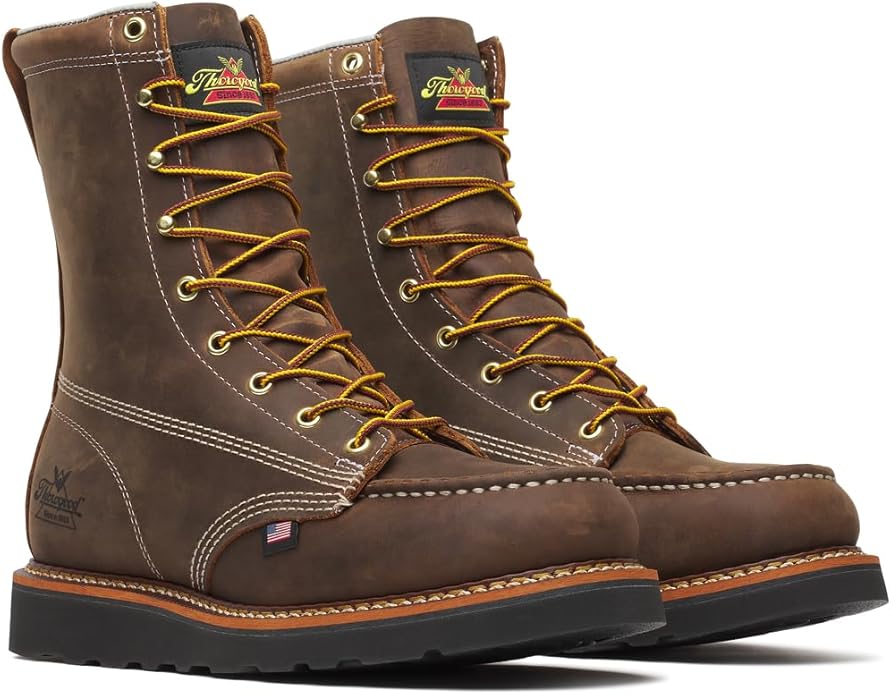Can You Walk on a Metal Roof? A Pro Roofer’s Guide to Doing It Safely (and When Not To)
The Short Answer
Yes, you can walk on most types of metal roofs, but it is not recommended without proper knowledge and safety equipment. The ability to walk safely depends entirely on the roof’s panel type, its structural support, the weather conditions, and using the correct technique to avoid damaging the roof or causing a life-threatening fall.
As a roofing contractor and safety consultant with over two decades of experience, “Can I walk on my metal roof?” is one of the most common questions I get from homeowners. My first, unfiltered answer is always, “You shouldn’t, unless you absolutely have to and know exactly what you’re doing.” I’ve been called to jobs to fix thousands of dollars in damage caused by a well-meaning homeowner trying to retrieve a frisbee, and I’ve seen the devastating consequences of a slip on what looked like a perfectly fine surface.

About the Author: John Carter
Roofing Contractor & Certified Safety Consultant (OSHA 500)
For more than 20 years, I’ve not only installed and repaired every type of metal roof imaginable, but I’ve also served as a safety trainer for roofing crews across the country. I’ve seen firsthand how a simple mistake can lead to permanent damage or serious injury. This guide is designed to give you the unvarnished truth about the risks and the precise techniques professionals use to stay safe and protect the integrity of the roof.
This guide isn’t just a simple yes or no. It’s a deep dive into the critical details that separate a safe walk from a disaster. We’ll cover the different types of metal panels and the specific techniques for each, the essential safety gear you must have, and the absolute red flags that mean you should call a professional, no matter what.
The High Stakes: Understanding the Risks of Damage and Danger
Before you even think about putting a ladder against the eave, you need to respect the two major risks: damaging your investment and injuring yourself.
Risk #1: Permanent Roof Damage
A metal roof is a durable, long-term investment. An improper footstep can cause costly and unsightly damage that may not be covered by your warranty.
- Denting and Bending: Stepping on the unsupported “flats” of certain panels can leave permanent dents. These aren’t just cosmetic; they can create low spots where water can pool, accelerating wear and tear.
- Scratching the Finish: Scuffing the protective coating with debris on your shoes can expose the underlying metal. This can compromise the roof’s aesthetics, especially if you ever need to paint a metal roof, and can lead to premature rust and corrosion.
- Compromising Seams: Putting weight on the seams of a standing seam roof or near the fasteners on an exposed-fastener roof can stress the connections, potentially leading to leaks that require professional repair with the best roof sealant.
If you damage your roof, you may face a difficult conversation with your insurance provider. It’s important to understand your policy and the implications, a topic homeowners often grapple with when wondering what happens if they don’t use their insurance money for professional repairs.
Risk #2: Life-Threatening Falls
Let me be blunt: a metal roof can be as slick as ice. The smooth, non-porous surface offers far less traction than asphalt shingles. Even the slightest bit of moisture—morning dew, a light drizzle, frost—can make it incredibly dangerous. Add in a bit of dust or pollen, and you have a recipe for disaster. A fall from a roof is a life-altering event. This is why for any work at height, professionals rely on a complete fall protection system, with the best roof harnesses being the absolute core of that system.
Know Your Roof: How to Walk on Different Metal Panel Types
The secret to safely walking on a metal roof is knowing its specific construction. You must only walk on the parts of the panel that are directly supported by the roof deck or underlying structure (purlins or battens). Here’s a breakdown of the most common types in the U.S.
Standing Seam Roofs
This is the strongest and generally safest type of metal roof to walk on. The panels are connected by raised, vertical “ribs” or seams.
Technique: Always walk on the flat “pan” area of the panel, as close to the raised ribs as possible. The area right next to the rib is the most supported. Keep your feet flat and your weight centered.
Avoid: Never, ever step directly on top of the raised ribs. They are not designed to bear weight and can be easily crushed, compromising the watertight seam.
Exposed Fastener (R-Panel / PBR-Panel)
These durable panels are common on both commercial buildings and modern residential homes. They are characterized by major and minor ribs and visible screws.
Technique: The only safe place to step is directly on the major ribs where you see the line of fasteners. This indicates the location of the purlin or truss underneath, providing solid support.
Avoid: The flat, unsupported areas between the major ribs. Stepping here will almost certainly cause a large, permanent dent.
Corrugated Panels (Classic “Wavy” Style)
Often found on agricultural buildings or older homes, these panels are thinner and more flexible. They require extra care.
Technique: Step on the highest point of the “wave” or corrugation, ideally where it is fastened to the structure below. Distribute your weight as evenly as possible.
Avoid: The “valley” or low point of the wave. This is the weakest part of the panel and will bend easily underfoot.
Metal Shingles or Tiles
These systems are designed to mimic the look of traditional shingles, slate, or tile. They are an aesthetic and durable choice, but not for foot traffic.
Technique: There is no universally safe technique. It is highly recommended to stay off these roofs entirely.
Avoid: Walking on these at all. The intricate locking edges and decorative stamping are easily damaged, leading to costly repairs.
Essential Gear for Safe Metal Roof Traversal
If you absolutely must get on your roof, having the right gear is non-negotiable. This isn’t about looking professional; it’s about staying alive and protecting your property.
1. High-Traction, Soft-Soled Footwear: Thorogood Wedge Boots
Hard-lugged work boots are your worst enemy on a metal roof. They minimize surface contact and can easily scratch the finish. You need soft, flexible soles that maximize surface area. The Thorogood Wedge boot is a favorite among professionals. Its soft polyurethane wedge sole provides a massive contact patch for incredible grip and won’t damage the roof panels. They are the gold standard for all-around roofing work.
Check Price on Amazon2. Personal Fall Arrest System (PFAS): Guardian “Bucket of Safe-Tie”
This is the most critical piece of equipment. A complete PFAS kit includes a harness, a rooftop anchor, and a lifeline. This Guardian kit is an industry-standard, all-in-one solution. The anchor is installed securely at the roof’s peak, and the lifeline connects your harness to it. This is the system that will save your life if you slip. Never step onto a sloped roof without being tied off.
Check Price on AmazonRed Flags: When to NEVER Walk on a Metal Roof
There are times when no amount of experience or gear makes it safe. If you encounter any of these conditions, stay on the ground and call a professional.
- When it’s Wet, Frosty, or Icy: This is an absolute no-go. The surface becomes dangerously slick.
- On Steep Pitches (Over 7/12): Walking on steeply pitched roofs requires specialized techniques and equipment beyond what a homeowner typically possesses.
- If You See Moss or Algae: These growths are extremely slippery even when dry.
- If You Don’t Have a Proper Fall Arrest System: Your safety is not worth the risk.
Frequently Asked Questions
Will walking on my metal roof void the warranty?
It can. Most manufacturer warranties cover defects in the material and finish, but they explicitly exclude damage caused by improper foot traffic or maintenance. If you dent a panel or scratch the finish by walking incorrectly, the subsequent repairs and any resulting issues (like rust) will likely not be covered. Always check your warranty documents.
What is the safest way to clean a metal roof without walking on it?
For light cleaning, you can often use a soft brush or a pressure washer on a long extension wand from the safety of a ladder at the eave or from the ground. For more intensive cleaning, it’s always best to hire a professional who has the proper safety equipment and experience to navigate the roof without causing damage.
I need to do a small repair. What should I have with me?
For minor repairs like sealing a fastener, you should have the manufacturer-approved sealant. It’s also wise to have a high-quality roofing tape designed for metal on hand for emergency patches. These items, along with your safety gear, should be carried in a tool belt to keep your hands free.
Does the type of metal roof matter in different climates?
Absolutely. For instance, the discussion around if metal roofs are good in Florida often centers on their high wind resistance and reflective properties. Similarly, the durability and water-shedding capabilities of flat roofs are key in coastal areas, though their walking surfaces are entirely different.
What about retrieving something or dealing with pests?
These are common reasons people want to get on their roofs. For a drone or a ball, use an extension pole if possible. For pest issues, like installing bird spikes or checking for entry points because you’re worried that roof rats are dangerous, it’s almost always safer and more effective to call a licensed and insured professional who deals with both roofing and pest control.
Final Verdict: Walk with Caution, or Better Yet, Don’t
So, can you walk on a metal roof? The technical answer is yes. The professional and responsible answer is that it should be avoided whenever possible and only attempted with the correct knowledge, technique, and an unwavering commitment to safety.
Your roof is an expensive and critical component of your home. Your health and safety are priceless. The cost of a professional service call is insignificant compared to the cost of a new roof panel or a medical emergency. Before you decide to climb that ladder, weigh the risks carefully. When in doubt, always make the safest choice: call a pro.



